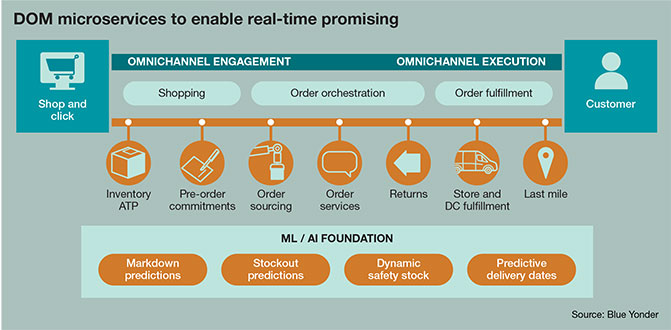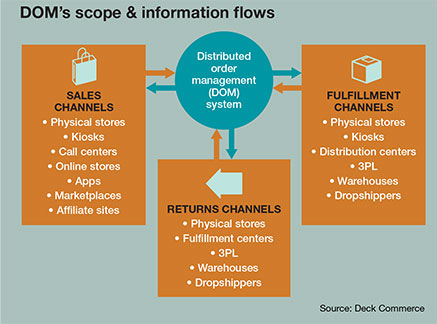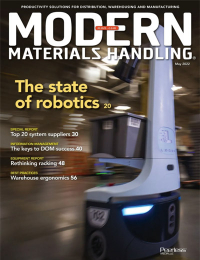The keys to Distribution Order Management (DOM) success
Distributed order management software centers on fulfillment rules and order routing logic, but DOM can also expose promise dates and shipping options with integration to front end e-commerce systems. Understanding the power of DOM’s enterprise view of inventory, its integration mechanisms and its dynamic rules engines are part of effective distributed order fulfillment.
Want to get items shipped to customers faster from the warehouse or store with the inventory? Want to show online customers what the actual shipping cost will be as they shop? And, do you want to do all that without interrupting inventory availability for other channels like store replenishment for your DC or walk-in traffic in your stores?
The means of achieving these objectives is wrapped up in a category of software known as distributed order management (DOM). These solutions, also known as order management system (OMS) solutions or enterprise order management, can do all these things, but fully leveraging DOM requires a deeper understanding of how it manages fulfillment using order routing logic, as well as real-time integration to multiple types of systems. What’s more, DOM can be used to address complexity for business-to-business fulfillment scenarios, not just for consumer-facing omnichannel selling.
Multiple factors ensure DOM deployments work well. Every warehouse or “node” configured in the system benefits from some type of site-level execution system to ensure inventory accuracy and update the DOM on event and transactions. Companies need to think strategically about which nodes will make up their network and the rules that will govern how to “route” or allocate orders across these nodes. You also need sufficient labor capacity to execute pick, pack, ship tasks at stores or to prepare buy online, pick up in store (BOPIS) orders.
“Order management solutions (OMS) or DOM have a lot of capabilities, but there’s quite a bit of change management involved in getting the most from these systems,” says David Mascitto, retail and e-commerce supply chain product marketing manager for Tecsys, which offers DOM from its 2018 acquisition of OrderDynamics. “But the benefits are worth it because it’s these order management capabilities that will enable you to get your orders to your customers faster, cheaper and more sustainably, while using all the inventory available to you.”
DOM’s core functions
DOM functionality can vary by vendor, but centers on both inventory visibility and the system’s order routing logic. Think of DOM as a layer of software that sits over systems like warehouse management systems (WMS) used in DCs or retail store systems, or WMS solutions from third-party logistics providers or drop shippers. It’s constantly in the know on inventory positions, interacting in real time with e-commerce software, or other systems that take customer orders, to relay reliable delivery promise dates and costs. At the heart of DOM functionality, however, is a rules engine that governs order routing decisions, says Dan Gilmore, chief marketing officer for Softeon.
Understanding how to leverage these configurable rules engines will help you get the most from the software, Gilmore adds, since the engine is what works in the background to allocate orders to inventory at fulfillment nodes, while automatically considering multiple factors like cost to ship, or other concerns like margin on an item or capacity to carry out fulfillment tasks.
“That rules engine is going to optimally determine what is the best sourcing location to use to generate the least cost transportation spend, while meeting customer requirements and service-level commitments and while considering network capacities and constraints,” explains Gilmore.
Integration counts
Integration to inventory data and transactions has always been part of DOM, but now vendors are looking to expose some fulfillment information from DOM directly into front-end e-commerce platforms before purchases are made, says Reyaz Mohamed, a vice president with Blue Yonder.
Here DOM acts as a real-time service exposed within the e-commerce storefront or marketplace so shoppers can see actual order “get by” dates and accurate shipping costs or BOPIS promises before they make a purchase, notes Mohamed.
“This information—the order promise date, that crucial get-by information—is sitting within the DOM solution and enhances that customer front-end journey,” explains Mohamed.

By exposing DOM insights as “microservices” to e-commerce platforms, DOM solutions can improve the customer experience.
For this trick to work, Mohamed adds, the DOM solution exposes its routing decisions and options to e-commerce software on a real-time basis. Some order management solutions can do this today, Mohamed adds, making DOM less of a back-end system to one that injects its capabilities straight into the customer experience.
“In effect, DOM is moving more into the front end of e-commerce, rather than being more of purely back-end system,” Mohamed says. “As companies seek to add more nodes, especially when it comes to the many stores a company may want to use as fulfillment nodes, which became more of a focus in the recent past due to e-commerce demand during Covid, you need an order management system that can handle much more scale and volume. Ten years ago, a DOM might tie into and manage inventory visibility for maybe five to 10 warehouses that acted as the nodes, but now the requirement may be to tie into hundreds of nodes.”
Another challenge is making stores a bit more like warehouses in terms of inventory accuracy and the ability to execute on order fulfillment processes. While DCs have a long history of using WMS to control inventory and guide associates through effective pick, pack and ship processes using mobile devices, stores can lack these capabilities.
That makes it important to first conduct a proper network strategy to determine which stores in which regions will act as fulfillment nodes with the DOM rollout. A DOM’s rules engine can help by doing things like setting limits on how much a smaller store can handle as a node within DOM.
“It’s absolutely critical to have an accurate view of what your stores are able to ship or pick for store pick up, so the DOM can make optimal sourcing decisions,” says Mohamed. “Oftentimes, having the inventory isn’t enough, you need the workforce capacity, too.”
For DOM to work well, Mohamed adds, the DOM needs proven integration capabilities, including to WMS and all the inventory transactions and order shipment events coming from a WMS, as well as ties into store-level systems that manage inventory, and of course, to e-commerce software from vendors like Shopify, Big Commerce, Magento, Salesforce, and others, as well as to any parcel shipping software that might be used to estimate shipping cost. Integration also ideally needs to be real-time integration based on application programming interfaces (APIs) rather than batch updates, adds Mohamed.
Inventory visibility and allocation logic are at the heart of DOM and OMS solutions, agrees Chris Deck, founder and CEO of Deck Commerce. Besides running its allocation or routing logic, a DOM solution needs to push an accurate available inventory view into each e-commerce selling platform or channel, which is especially important to direct-to-consumer (DTC) brands, says Deck.
“Before you even get to the allocation [function], the key is exposing that inventory view to upstream selling platforms in the most efficient manner, to maximize your ability to turn the inventory, while minimizing your risk of overselling and having to do order cancellations,” Deck explains.
For example, Deck says, sellers on eBay seek to maintain a perfect seller record, which can be negatively impacted if a DTC brand’s OMS cannot send an accurate inventory position up to eBay. DOM solutions for DTC brands need to be adept at quickly orchestrating allocations and providing updated inventory availability to each e-commerce channel to ensure a positive customer experience.
“The order management solution has to be able to manage those allocations to provide an accurate, available-to-sell picture in as close to real-time as possible,” says Deck.
DOM integration often reaches out to multiple systems, even at the same company. For example, Browns Shoes, a user of Tecsys’s DOM solution, tied five different retail systems into the solution to achieve an enterprise-wide view of inventory at its stores and its DC and to create a single unified commerce solution for filling orders.
The DOM provides an order consolidation capability from this unified view of inventory. Browns Shoes reduced the overall order lead time by 13% in the first month with the system; they compressed the order-to-fulfillment cycle time to as low as 15 minutes, while ensuring a 99.5% level of fulfillment and order accuracy.
Integration is crucial to DOM success, Gilmore agrees, in that inevitably there are many systems to tie into, including systems used by third-party logistics providers (3PL). “To be successful at DOM, as the solution provider, you need to be an integration specialist,” says Gilmore.

DOM systems sync inventory, transaction and fulfillment data across channels.
The role of rules
Understanding how to leverage the rules engine in DOM is key to success with projects, adds Gilmore, who calls the dynamic rules engine function a “foundational” element of DOM. A good rules engine allows a DOM to instantly weigh different factors to come up with the optimal routing decision.
The rules engine should be able to address factors like shipping cost and geographic distance, speed of delivery or other issues like how many ship-from-store orders a single store can realistically handle in a day. “If you can define a rule in English, you can define it in our DOM’s rule engine, so there is a tremendous amount of flexibility in setting up the business rules,” says Gilmore.
Initially, a DOM deployment can be kept fairly simple in terms of rules configuration, looking mainly at factors like shipping cost from each node, but you can add further rules as you gain experience. “A lot of times retailers will start with a region and start to do fulfillment from a cluster of nodes, get some learnings, and then adapt what they want their policies to be,” says Gilmore.
For example, the DOM’s rules engine could be used to set an upper limit on how many orders a store can pick, pack and ship. If a store gets very busy with shoppers, and starts to fall behind on filling online orders, the DOM could route additional orders to a different store serving as a node for the region.
“All these decisions just happen automatically,” Gilmore says. “That is what is so wonderful about this technology—once you configure the rules, very little human intervention is involved.”
Softeon’s DOM solution also can perform simulations to test scenarios like adding more stores or warehouses to the fulfillment network, or adjusting inventory policies around how much inventory to keep at a store, and then running a block of order data through the software. “You can run that data through the DOM and see how things actually play out, in terms of impact on logistics cost, or what the impact is on improving service levels,” says Gilmore.
DOM’s ability to flexibly set rules over how to fulfill demand with inventory sitting across nodes can be useful to business-to-business (B2B) scenarios, not just figuring out how to best get goods to online consumers, adds Gilmore.
For example, Sears Home Services uses Softeon’s DOM and WMS to manage repair parts inventory and fulfillment in a multi-echelon network, including parts held in master DCs down to parts held in an individual technician’s van, as well as reverse logistics to optimize the process of returning parts for restocking, scrapping or repair.
“It’s using DOM’s integration capabilities and dynamic rules engine to manage similar variables regarding inventory availability and issues like logistics costs, but just in a B2B context,” says Gilmore.
Business agility
Companies that invested in DOM before the pandemic were in a better position to quickly pivot to using stores as fulfillment nodes, says Amy Tennent, a senior director of product management at Manhattan Associates.
For example, Kendra Scott, an Austin, Texas-based jewelry retailer was already using Manhattan’s OMS to facilitate DOM from DCs when the pandemic hit. Kendra Scott’s retail stores shut to in-person shopping at one point during Covid, and its main DC was reduced to minimum operations due to safety measures.

Some DOM solutions are able to consider how many orders can be processed per day from stores.
Kendra Scott realized it should look at using stores to fill e-commerce orders, explains Tennent, and within one business day had configured Manhattan’s Store Order Fulfillment solution, along with the OMS logic on routing decisions, and within six business days was able to begin leveraging some stores to fulfill e-commerce orders. Kendra Scott and Manhattan quickly collaborated on curbside pickup functionality using the OMS and store solutions.
“If you don’t have an order management solution in place already, this ability to quickly turn on that type of ship-from-store functionality is harder to achieve because it’s a bigger project. When you have an order management solution that is flexible and configurable, you have the ability to adapt your fulfillment processes and strategy very quickly,” Tennent says.
While WMS solutions are widely used in large DCs, advanced WMS is seen as out of place in a store environment. Enterprises leveraging stores as fulfillment nodes are better off with purpose-built fulfillment solutions for the store environment, enabling optimized picking strategies, dynamic prioritization, notifications and alerting, says Tennent.
DOM order routing algorithms enable retailers to more profitability leverage store inventory by helping them move inventory they want to move, like e-commerce returns in resaleable condition or store inventory that is due for a big price markdown, says Tennent.
DOM also can aid retailers in meeting customer expectations by integrating with WMS solutions and stores in real-time, adds Tennent, so if a customer decides to add an item to an order just after placing it, or canceling an item, or changing the ship to data, the change can be facilitated without frustrating customers by saying the order already has been sent to the warehouse.

Article Topics
Order Management System News & Resources
The Paccurate Report Pivotree and GreyOrange partner on order fulfillment capabilities Körber to acquire enVista’s OMS platform and freight audit and payment service The keys to Distribution Order Management (DOM) success Titan Brands addresses omnichannel transformation via enVista and Körber JOANN Stores masters ship-from-store, pickup-in-store & curbside pickup during a pandemic Softeon partners with S3Group More Order Management SystemLatest in Materials Handling
Geek+ and System Teknik deploy PopPick solution for pharmacy group Med24.dk Beckhoff USA opens new office in Austin, Texas Manhattan Associates selects TeamViewer as partner for warehouse vision picking ASME Foundation wins grant for technical workforce development The (Not So) Secret Weapons: How Key Cabinets and Asset Management Lockers Are Changing Supply Chain Operations MODEX C-Suite Interview with Harold Vanasse: The perfect blend of automation and sustainability Consultant and industry leader John M. Hill passes on at age 86 More Materials HandlingAbout the Author
Subscribe to Materials Handling Magazine

Find out what the world's most innovative companies are doing to improve productivity in their plants and distribution centers.
Start your FREE subscription today.
April 2024 Modern Materials Handling

Latest Resources












